Intro
Unlock the Meld Score Interpretation Guide to understand your risk assessment. Learn to interpret scores, mitigate risks, and make informed decisions with our comprehensive guide, covering risk management, assessment, and analysis techniques.
The MELD score, which stands for Model for End-Stage Liver Disease, is a crucial tool used by healthcare professionals to assess the severity of liver disease in patients. It is particularly important for those awaiting liver transplantation, as it helps prioritize patients based on the urgency of their need for a transplant. Understanding the MELD score and its interpretation is vital for both medical professionals and patients to grasp the prognosis and management of liver disease.
The MELD score is calculated based on three key laboratory values: bilirubin, creatinine, and international normalized ratio (INR) for prothrombin time. These values reflect the liver's ability to perform its basic functions, such as detoxification, protein synthesis, and production of biochemicals necessary for digestion. A higher MELD score indicates more severe liver dysfunction and a higher priority for liver transplantation.
The calculation of the MELD score involves a complex formula that takes into account the natural logarithm of these laboratory values. The score ranges from 6 to 40, with higher scores indicating a higher risk of mortality within 90 days without a liver transplant. The MELD score is dynamic and can change over time as the patient's condition improves or worsens, reflecting the progression of liver disease or the effectiveness of interventions.
MELD Score Calculation and Interpretation
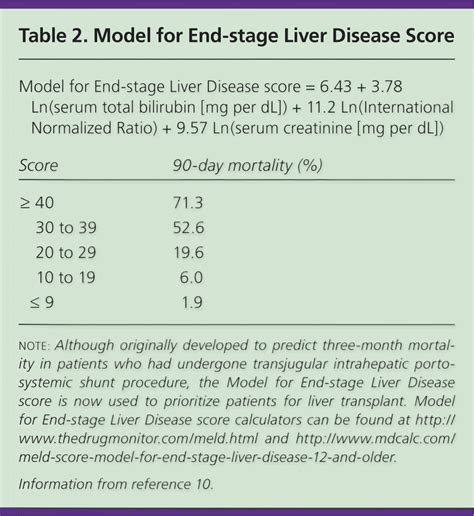
The MELD score calculation is as follows: MELD = 10 * (0.957 * ln(creatinine) + 0.378 * ln(bilirubin) + 1.120 * ln(INR)) + 0.643. This formula provides a numerical value that correlates with the risk of mortality. The score is then rounded to the nearest whole number, and any value less than 6 is assigned a score of 6, while any value greater than 40 is assigned a score of 40.
Understanding MELD Score Ranges
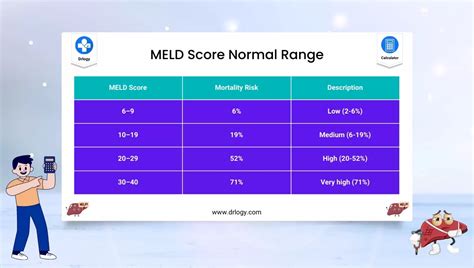
The interpretation of the MELD score is crucial for determining the priority of liver transplantation. Generally, patients with higher MELD scores are considered to have a higher risk of short-term mortality and are prioritized for transplantation. The ranges of the MELD score and their interpretations are as follows:
- A MELD score of 6-10 indicates mild liver disease, with a relatively low risk of short-term mortality.
- A score of 11-18 suggests moderate liver disease, with an increasing risk of mortality.
- Scores of 19-24 indicate severe liver disease, with a significant risk of mortality within 90 days.
- A MELD score of 25-30 reflects very severe liver disease, with a high risk of mortality.
- Scores above 30 are associated with an extremely high risk of mortality and indicate critical liver disease.
Factors Influencing MELD Score
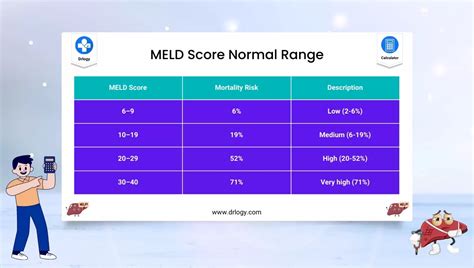
Several factors can influence the MELD score, including the patient's laboratory values, the presence of complications such as hepatorenal syndrome or hepatic encephalopathy, and the patient's overall health status. For instance, patients with hepatorenal syndrome, a type of kidney dysfunction that occurs in advanced liver disease, may receive additional points, increasing their MELD score and prioritization for transplantation.
Limitations and Controversies of the MELD Score
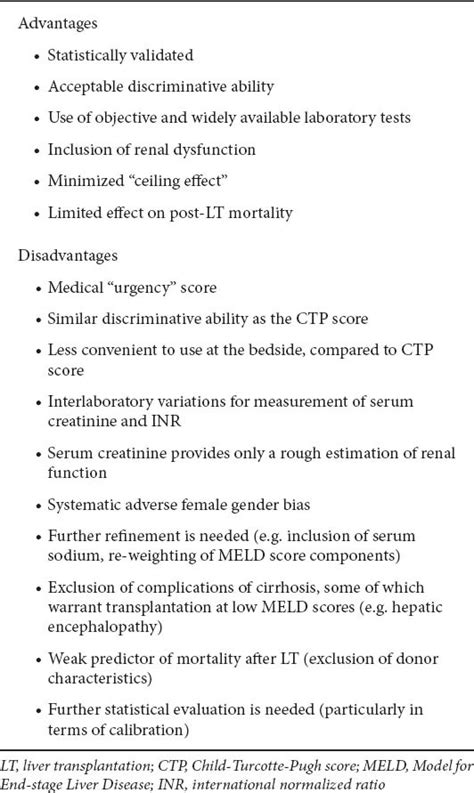
While the MELD score is a valuable tool for assessing the severity of liver disease, it has several limitations and controversies. For example, it does not account for other important factors that may influence the patient's prognosis, such as the presence of hepatocellular carcinoma (liver cancer), portal vein thrombosis, or the patient's overall quality of life. Additionally, the MELD score may not accurately reflect the severity of liver disease in certain populations, such as those with autoimmune hepatitis or primary biliary cirrhosis.
Alternatives and Modifications to the MELD Score
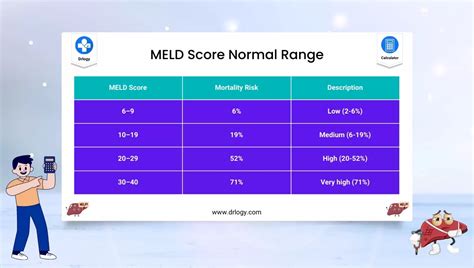
To address the limitations of the MELD score, several alternatives and modifications have been proposed. For instance, the MELD-Na score incorporates serum sodium levels into the calculation, as hyponatremia (low sodium levels) is a predictor of mortality in patients with cirrhosis. Other scoring systems, such as the Child-Turcotte-Pugh (CTP) score, also assess the severity of liver disease but use a combination of laboratory values and clinical parameters.
Clinical Applications of the MELD Score
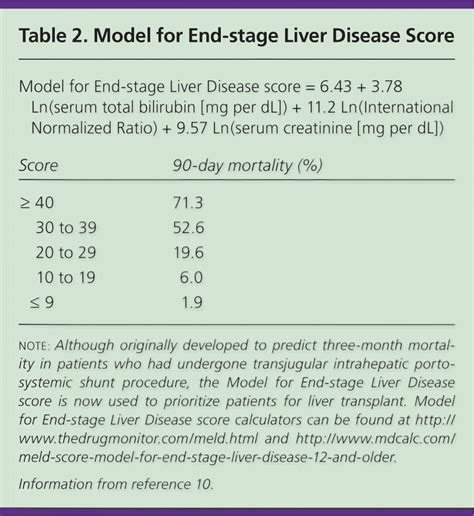
The MELD score has several clinical applications, including prioritizing patients for liver transplantation, guiding the management of patients with liver disease, and predicting mortality risk. Healthcare providers use the MELD score to determine the optimal timing for liver transplantation and to allocate organs to those with the greatest need.
Future Directions and Research
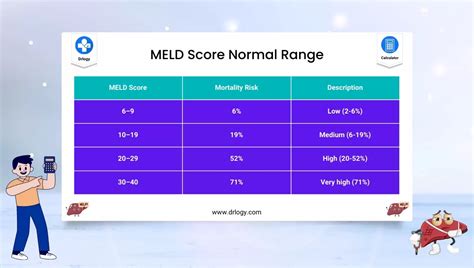
Ongoing research aims to refine the MELD score and develop new scoring systems that better predict mortality and prioritize patients for liver transplantation. For example, studies are investigating the incorporation of novel biomarkers, such as liver stiffness measurements or genetic markers, into the MELD score calculation. Additionally, there is a growing interest in using machine learning algorithms to develop more accurate and personalized predictive models for liver disease severity.
Conclusion and Final Thoughts
In conclusion, the MELD score is a valuable tool for assessing the severity of liver disease and prioritizing patients for liver transplantation. While it has limitations and controversies, it remains a cornerstone in the management of patients with liver disease. As research continues to refine and improve scoring systems, healthcare providers will be better equipped to provide personalized care and optimize outcomes for patients with liver disease.What is the MELD score used for?
+The MELD score is used to assess the severity of liver disease and prioritize patients for liver transplantation.
How is the MELD score calculated?
+The MELD score is calculated using a formula that incorporates laboratory values such as bilirubin, creatinine, and INR.
What are the limitations of the MELD score?
+The MELD score has several limitations, including not accounting for other important factors that may influence the patient's prognosis, such as the presence of hepatocellular carcinoma or portal vein thrombosis.
We invite readers to share their thoughts and experiences with the MELD score in the comments section below. If you found this article informative, please consider sharing it with others who may benefit from this information. Together, we can work towards improving our understanding and management of liver disease.
